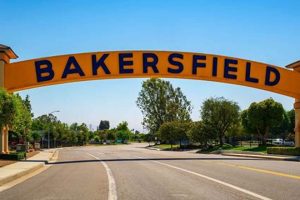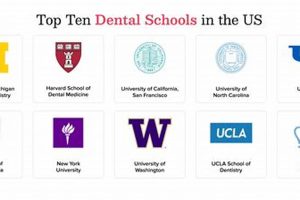Top-tier institutions offering archaeology programs provide rigorous training in excavation techniques, artifact analysis, and cultural heritage management. Students gain practical experience through fieldwork opportunities and develop expertise in specific archaeological subfields, such as prehistoric archaeology, historical archaeology, or bioarchaeology. For example, an institution might offer specialized training in underwater archaeology, providing students with the skills and knowledge necessary to explore and document submerged archaeological sites.
A strong educational foundation in archaeology is essential for preserving and understanding human history. Experts in this field contribute significantly to our knowledge of past civilizations, societal evolution, and human adaptation to changing environments. Furthermore, the ethical considerations within archaeology, such as site preservation and repatriation of cultural objects, are increasingly critical aspects of professional practice. The discipline has evolved from treasure hunting to a scientific pursuit aimed at reconstructing past lifeways and protecting cultural heritage for future generations.
This discussion will further explore key factors to consider when selecting an archaeology program, including faculty expertise, research opportunities, and available resources. Specific examples of renowned institutions and their unique program offerings will also be highlighted.
Tips for Selecting a Top Archaeology Program
Choosing the right archaeology program is crucial for a successful career in the field. Careful consideration of several factors can ensure a rewarding educational experience and strong professional preparation.
Tip 1: Research Faculty Expertise: Investigate the faculty’s research specializations and publications. Align program selection with specific areas of archaeological interest, such as classical archaeology or Egyptology.
Tip 2: Evaluate Fieldwork Opportunities: Prioritize programs offering robust fieldwork experiences, including both domestic and international projects. Hands-on training is essential for developing practical skills.
Tip 3: Consider Available Resources: Assess the institution’s facilities, such as laboratories, libraries, and museums. Access to specialized equipment and collections enhances research and learning opportunities.
Tip 4: Explore Interdisciplinary Connections: Seek programs that encourage interdisciplinary studies. Connections with related fields, such as anthropology, history, or geography, provide a broader perspective on archaeological research.
Tip 5: Assess Program Accreditation: Verify the program’s accreditation status to ensure it meets established quality standards. Accreditation signals a commitment to rigorous academic standards and professional training.
Tip 6: Investigate Funding Opportunities: Explore available scholarships, grants, and assistantships to support educational expenses. Financial aid can significantly reduce the burden of tuition and other costs.
Tip 7: Connect with Current Students and Alumni: Reach out to current students and alumni to gain firsthand insights into the program’s strengths and weaknesses. Their perspectives offer valuable information about the learning environment and career prospects.
By considering these factors, prospective students can identify programs that align with their academic and career goals. A well-chosen program provides a strong foundation for a successful and fulfilling career in archaeology.
These tips provide a starting point for navigating the process of selecting an archaeology program. Further research and careful consideration will ensure a well-informed decision that sets the stage for a successful career in this fascinating field.
1. Faculty Expertise
Faculty expertise significantly contributes to the quality and reputation of archaeology programs. Distinguished faculty members bring a wealth of knowledge and experience, shaping curriculum development, mentoring students, and leading cutting-edge research. Their specialized knowledge in areas such as archaeological theory, regional specializations, or specific methodologies provides students with in-depth training and fosters intellectual growth. For instance, a program specializing in underwater archaeology benefits immensely from faculty with extensive experience in maritime excavation and artifact conservation. Similarly, institutions known for Mesoamerican archaeology often feature faculty who have directed major excavations and published extensively on the subject. This concentration of expertise allows institutions to offer specialized courses and research opportunities, attracting students with specific interests and career goals. The presence of renowned experts also enhances an institution’s reputation, attracting research funding and fostering collaborations with other leading institutions.
The influence of faculty expertise extends beyond the classroom. Experienced faculty members often involve students in their research projects, providing invaluable hands-on training and mentorship. Such opportunities allow students to gain practical experience in fieldwork, laboratory analysis, and academic publication, preparing them for successful careers in archaeology. Faculty mentorship also plays a crucial role in guiding students’ career paths, connecting them with professional networks, and fostering a sense of community within the discipline. The quality of faculty advising and mentorship can significantly impact a student’s long-term success and contribute to the overall reputation of the program.
In summary, faculty expertise serves as a cornerstone of high-quality archaeology programs. The presence of accomplished scholars not only enhances the learning experience but also strengthens the program’s reputation and fosters a vibrant research environment. Prospective students should carefully consider the faculty’s specializations, publications, and research activities when selecting an archaeology program to ensure alignment with their own academic and career aspirations. This careful evaluation is essential for maximizing the educational experience and achieving professional success in the field of archaeology. The long-term benefits of learning from leading experts in the field are undeniable, impacting both individual career trajectories and the advancement of archaeological knowledge.
2. Fieldwork Opportunities
Robust fieldwork opportunities are a defining characteristic of top archaeology programs. Practical experience gained through excavations and surveys is essential for developing the skills necessary for a successful career. These experiences provide students with hands-on training in excavation techniques, artifact handling and documentation, site mapping, and data analysis. Participating in fieldwork allows students to apply theoretical knowledge learned in the classroom to real-world scenarios, fostering a deeper understanding of archaeological principles. For example, a program offering fieldwork at a Roman villa in Italy provides students with specialized skills in classical archaeology, while a program excavating prehistoric mounds in the American Midwest offers expertise in North American prehistory. The diversity and quality of fieldwork opportunities directly correlate with the overall quality of the educational experience.
The benefits of fieldwork extend beyond technical skill development. Fieldwork fosters collaboration and teamwork, crucial skills in any archaeological endeavor. Students learn to work effectively within a team, contributing their individual skills while learning from the expertise of others. These experiences also build problem-solving skills, as fieldwork often presents unexpected challenges that require creative solutions. Furthermore, fieldwork experiences often provide networking opportunities, connecting students with established professionals and potential employers. The combination of practical skills, collaborative experience, and professional networking gained through fieldwork significantly enhances career prospects.
In summary, the availability and quality of fieldwork opportunities are critical factors to consider when evaluating archaeology programs. Institutions offering diverse and well-structured fieldwork experiences provide students with the essential skills, knowledge, and connections needed to thrive in the field of archaeology. The practical application of classroom learning through hands-on fieldwork experiences bridges the gap between theory and practice, producing well-rounded and highly sought-after graduates. The emphasis on fieldwork serves as a benchmark of quality, distinguishing top archaeology programs from those offering primarily theoretical instruction.
3. Research Facilities
State-of-the-art research facilities are a hallmark of leading archaeology programs. Access to advanced equipment and resources is essential for conducting cutting-edge research and providing students with high-quality training. These facilities serve as hubs for innovation and collaboration, fostering a dynamic learning environment and attracting top scholars. The availability and sophistication of research facilities directly impact the quality and scope of research conducted, influencing both student training and faculty scholarship.
- Archaeometry Laboratories:
Dedicated laboratories equipped for materials analysis, such as radiocarbon dating, X-ray fluorescence spectrometry, and micromorphology, are crucial for in-depth artifact examination. These facilities allow researchers to determine the age, composition, and provenance of artifacts, providing critical insights into past technologies and trade networks. For example, access to scanning electron microscopes allows for detailed analysis of artifact surfaces, revealing microscopic traces of use-wear and manufacturing techniques. The presence of well-equipped archaeometry laboratories is a key indicator of a program’s commitment to scientific rigor and advanced research.
- GIS and Spatial Analysis Labs:
Geographic Information Systems (GIS) and spatial analysis software play an increasingly important role in archaeological research. Dedicated computer labs equipped with this software enable students and faculty to create detailed maps, analyze spatial patterns, and model past landscapes. This technology facilitates site location, predictive modeling for undiscovered sites, and landscape-scale analyses of settlement patterns and resource utilization. For instance, GIS can be used to analyze the distribution of artifacts across a site, revealing activity areas and social organization. Proficiency in GIS is a highly sought-after skill in the field of archaeology, and access to specialized labs provides students with a competitive edge.
- Collections and Archives:
Extensive collections of artifacts, documents, and archaeological reports provide invaluable resources for research and teaching. Access to well-curated collections allows students to examine artifacts firsthand, conduct comparative analyses, and develop object-based research projects. Comprehensive archives containing field notes, photographs, and maps from previous excavations provide historical context and support ongoing research. For example, access to a collection of prehistoric pottery allows students to study stylistic changes over time and infer cultural interactions. Well-maintained collections and archives serve as repositories of knowledge, supporting both student learning and faculty research.
- Digital Archaeology Labs:
Digital technologies are transforming archaeological practice. Specialized labs equipped with 3D scanners, photogrammetry software, and virtual reality platforms enable the creation of detailed digital models of artifacts, sites, and landscapes. These digital tools facilitate data visualization, analysis, and preservation, opening up new avenues for research and public engagement. For instance, 3D models of artifacts can be shared online, making them accessible to researchers and the public worldwide. Programs investing in digital archaeology labs are at the forefront of the field, equipping students with the cutting-edge skills needed for the future of archaeological research.
The quality and availability of these research facilities are critical indicators of a program’s commitment to excellence. Institutions investing in state-of-the-art research infrastructure provide students with unparalleled opportunities for hands-on training and cutting-edge research. The integration of advanced technology, comprehensive collections, and specialized labs fosters a dynamic and stimulating research environment, attracting top faculty and students. The strength of a program’s research facilities directly contributes to its overall reputation and the success of its graduates in the competitive field of archaeology. This investment in research infrastructure underscores a commitment to advancing archaeological knowledge and preparing students for leadership roles in the field.
4. Program Focus
A clearly defined program focus distinguishes top archaeology programs. Specialization allows institutions to concentrate resources, attract leading faculty in specific subfields, and provide students with in-depth training. This focus fosters a cohesive intellectual community and strengthens the program’s reputation. For example, a program specializing in maritime archaeology might offer advanced courses in shipwreck excavation and nautical archaeology, attracting students specifically interested in this subfield. Similarly, a program focusing on prehistoric archaeology could offer specialized training in lithic analysis and paleobotany. A well-defined program focus allows institutions to carve a unique niche within the broader field of archaeology, attracting students and faculty with shared research interests and contributing specialized knowledge to the discipline. Institutions with broader programs often lack this concentrated expertise, resulting in a more diluted curriculum.
The benefits of a focused program extend beyond specialized coursework. Focused programs often foster strong connections with related departments and research centers, such as museums, cultural heritage organizations, or government agencies. These connections provide students with access to specialized resources, internship opportunities, and career networks. For example, a program specializing in cultural heritage management might collaborate with local museums, providing students with practical experience in collections management and public outreach. These partnerships enrich the learning experience and enhance career prospects. A programs focus can also influence the types of research projects undertaken by faculty and students, leading to significant contributions within specific subfields. This concentrated research effort can result in groundbreaking discoveries and establish the program as a leader in its area of specialization.
In summary, a well-defined program focus is a critical component of leading archaeology programs. This focus allows institutions to develop specialized expertise, attract top faculty and students, and make significant contributions to archaeological knowledge. Choosing a program with a clear focus aligned with one’s research interests is crucial for maximizing the educational experience and future career opportunities. Understanding the nuances of program focus allows prospective students to make informed decisions tailored to their specific academic and professional goals within the diverse field of archaeology.
5. Global Recognition
Global recognition plays a crucial role in defining top archaeology programs. Internationally renowned institutions attract a diverse student body, foster collaborative research projects, and offer broader career opportunities. This recognition stems from a combination of factors, including faculty expertise, research output, program quality, and alumni achievements. Understanding the components and implications of global recognition is essential for prospective students evaluating archaeology programs.
- International Faculty and Student Body:
Globally recognized programs attract students and faculty from diverse backgrounds, creating a rich and stimulating learning environment. This internationalization fosters cross-cultural exchange, exposes students to varied perspectives, and prepares them for collaborative work in an increasingly globalized field. A diverse cohort enriches classroom discussions, introduces students to different archaeological traditions, and enhances networking opportunities.
- Impactful Research and Publications:
Institutions with global recognition often have faculty engaged in high-impact research published in prestigious international journals. This research contributes significantly to advancing archaeological knowledge and influences the direction of the field. For example, groundbreaking discoveries in a specific region or innovative methodological advancements can elevate an institution’s global standing. This research output attracts funding, fosters international collaborations, and provides students with opportunities to participate in cutting-edge projects.
- International Collaborations and Fieldwork:
Top archaeology programs often have established partnerships with institutions and research projects worldwide. These collaborations provide students with access to diverse fieldwork opportunities, international research networks, and broader career prospects. For example, a program with strong ties to research projects in Egypt might offer students unique fieldwork opportunities at prominent archaeological sites. International fieldwork experiences enhance students’ skill sets, expose them to different archaeological contexts, and build international collaborations.
- Alumni Success and Network:
The success of a program’s alumni network contributes significantly to its global recognition. Graduates securing prestigious positions in academia, cultural heritage management, or related fields enhance the program’s reputation and create a strong alumni network. This network provides current students with mentorship opportunities, career guidance, and access to a global professional community. A robust alumni network serves as a testament to the program’s quality and contributes to its long-term success.
These interconnected facets contribute to an institution’s global recognition, impacting program quality, student experience, and career prospects. Prospective students seeking a high-quality archaeological education should consider global recognition as a key factor in their program selection process. Choosing a globally recognized program provides access to a broader range of resources, fosters international connections, and enhances career opportunities in a competitive field. Ultimately, global recognition reflects a program’s commitment to excellence and its contribution to the advancement of archaeological knowledge.
6. Alumni Network
A strong alumni network is a hallmark of leading archaeology programs, serving as a crucial link between academic training and professional practice. The network’s strength and engagement significantly impact career prospects, research opportunities, and the program’s overall reputation. Examining the components of a robust alumni network reveals its importance in defining top archaeology programs.
- Mentorship and Career Guidance:
Established professionals within the alumni network often provide mentorship and career guidance to recent graduates. This support can be invaluable in navigating the competitive job market, securing internships, and making informed career decisions. Experienced alumni can offer insights into different career paths, provide feedback on job applications, and connect graduates with potential employers. Mentorship programs, alumni networking events, and online platforms facilitate these connections, fostering a supportive community that extends beyond graduation.
- Networking and Collaboration:
Alumni networks facilitate connections among graduates working in diverse sectors, including academia, cultural resource management, museums, and government agencies. These connections create opportunities for collaboration on research projects, grant applications, and professional development initiatives. Alumni working in different regions or specializing in various subfields can expand the network’s reach and create interdisciplinary opportunities. Conferences, workshops, and online forums organized by the alumni network strengthen these connections and foster a sense of community.
- Program Support and Advocacy:
Active alumni networks often contribute to the program’s ongoing success through financial support, advocacy, and recruitment efforts. Alumni donations can fund scholarships, fieldwork opportunities, and research initiatives, enhancing the program’s resources and attracting top students. Alumni also serve as advocates for the program within their professional communities, promoting its reputation and attracting prospective students. Their active involvement demonstrates a commitment to the program’s long-term success and strengthens its position within the field.
- Professional Development and Continuing Education:
Many alumni networks offer continuing education opportunities, such as workshops, webinars, and conferences, to help graduates stay current with the latest advancements in the field. These programs provide valuable professional development opportunities, enhancing skills and knowledge throughout alumni careers. Access to continuing education resources demonstrates the network’s commitment to supporting lifelong learning and maintaining high professional standards among its members. These opportunities also strengthen connections within the alumni network, fostering ongoing collaboration and knowledge sharing.
These interconnected components highlight the crucial role of a robust alumni network in defining top archaeology programs. A strong and engaged alumni network enhances career prospects, fosters research collaborations, and strengthens the program’s reputation. Prospective students should consider the strength and activity of the alumni network as a key factor when evaluating archaeology programs. A vibrant alumni network provides invaluable support throughout a graduate’s career, contributing significantly to their professional success and the advancement of the field.
7. Financial Aid
Financial aid plays a critical role in accessing high-quality archaeology programs. The cost of tuition, fees, fieldwork, and research materials can present significant barriers to entry. Robust financial aid programs enable talented students from diverse socioeconomic backgrounds to pursue their educational and career goals in archaeology, contributing to a more inclusive and equitable field. Understanding the various forms of financial aid available is essential for prospective students seeking to attend leading archaeology programs.
- Scholarships and Grants:
Scholarships and grants provide crucial funding for students pursuing archaeology degrees, often based on academic merit, research potential, or specific criteria such as geographic origin or area of study. Institutions and external organizations offer these awards, reducing financial burdens and enabling students to focus on their studies. Merit-based scholarships recognize outstanding academic achievements, while need-based grants provide support to students facing financial hardship. Specialized scholarships may also be available for students pursuing specific subfields, such as underwater archaeology or bioarchaeology. These awards can significantly reduce the cost of education, making top programs accessible to a wider range of students.
- Fellowships and Assistantships:
Fellowships and assistantships provide financial support in exchange for research or teaching contributions. Fellowships often support dissertation research or postdoctoral studies, while assistantships involve teaching undergraduate courses or assisting with laboratory work. These opportunities provide valuable professional experience while offsetting educational expenses. Research assistantships allow students to collaborate with faculty on ongoing projects, gaining valuable research skills and contributing to the advancement of knowledge. Teaching assistantships provide experience in pedagogy and communication, valuable skills for academic careers. These positions provide both financial support and practical training, enhancing career prospects.
- Loans and Work-Study Programs:
Loans and work-study programs offer additional avenues for financing archaeological education. Federal and private loans provide funding that students repay after graduation, while work-study programs offer part-time employment opportunities within the university. These options can help bridge the gap between other forms of financial aid and the total cost of attendance. Work-study positions can provide valuable experience in related fields, such as museum studies or archival research. Careful consideration of loan terms and repayment options is crucial for managing long-term financial obligations. Understanding the various loan programs available is essential for making informed decisions.
- External Funding Opportunities:
Numerous organizations outside of universities offer grants and fellowships specifically for archaeological research and training. Professional organizations, foundations, and government agencies provide funding for fieldwork, laboratory analysis, and dissertation research. Seeking out and securing these external funding opportunities demonstrates initiative and enhances a student’s research profile. For example, organizations like the National Geographic Society and the Wenner-Gren Foundation offer grants for archaeological research worldwide. These external funding sources can supplement institutional aid, allowing students to pursue ambitious research projects and gain valuable experience.
Access to comprehensive financial aid packages is a key factor in attending the best schools for archaeology. Robust financial aid programs level the playing field, enabling talented students from all backgrounds to pursue their passion for archaeology. By understanding the diverse range of funding opportunities available, prospective students can make informed decisions about financing their education and gain access to world-class training and research experiences. The availability of substantial financial aid often distinguishes leading archaeology programs, attracting top students and fostering a diverse and vibrant intellectual community. This investment in student support underscores a commitment to excellence and contributes to the advancement of the field.
Frequently Asked Questions
This section addresses common inquiries regarding the selection and pursuit of archaeology programs.
Question 1: What are the typical admission requirements for archaeology programs?
Admission requirements vary among institutions, but generally include a bachelor’s degree, transcripts demonstrating strong academic performance, letters of recommendation, and a statement of purpose outlining research interests and career goals. Some programs may require GRE scores or specific prerequisite courses.
Question 2: How important is fieldwork experience prior to applying to graduate programs?
Prior fieldwork experience is highly beneficial but not always mandatory. Demonstrated interest in archaeology through volunteer work, museum internships, or participation in field schools can strengthen an application. Many programs offer introductory fieldwork opportunities for students lacking prior experience.
Question 3: What career paths are available to archaeology graduates?
Career paths in archaeology are diverse, including academic research, cultural resource management (CRM), museum curation, public archaeology, and government service. A graduate degree often opens doors to more specialized and senior roles.
Question 4: How does one choose between a master’s and a doctoral program in archaeology?
A master’s degree provides a solid foundation for many professional careers in archaeology, including CRM and museum work. A doctoral degree is typically required for academic research and teaching positions. Career goals should guide program selection.
Question 5: What is the typical duration of archaeology graduate programs?
Master’s programs typically take two to three years to complete, while doctoral programs can range from four to seven years depending on research progress and dissertation completion.
Question 6: How can one identify programs with a strong focus on a specific archaeological subfield?
Reviewing faculty research interests, course offerings, and available research facilities allows prospective students to determine program strengths. Examining recent publications and ongoing research projects provides further insights into departmental specializations.
Careful consideration of these frequently asked questions will assist prospective students in making informed decisions about their archaeological education and career paths. Thorough research and thoughtful planning are essential for success in this challenging and rewarding field.
Further resources and information regarding specific programs can be found on institutional websites and through professional archaeological organizations. Consulting with academic advisors and current archaeology students also provides valuable insights.
Conclusion
Selection of leading archaeology programs requires careful evaluation of several key factors. Faculty expertise, robust fieldwork opportunities, state-of-the-art research facilities, program focus, global recognition, a strong alumni network, and access to financial aid are crucial aspects to consider. Each element contributes significantly to the quality of education and preparation for successful careers. Prioritizing these factors empowers prospective students to make informed decisions aligned with their academic and professional aspirations within this dynamic field.
The pursuit of archaeological knowledge demands rigorous training and dedication. By carefully considering these key components, aspiring archaeologists can identify institutions best suited to cultivate their potential and contribute meaningfully to the preservation and understanding of human history. The future of archaeology relies on well-trained professionals equipped to address complex research questions and contribute to cultural heritage management worldwide. Choosing the right educational path is the first step toward a fulfilling and impactful career in this vital field.







